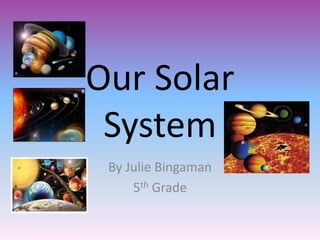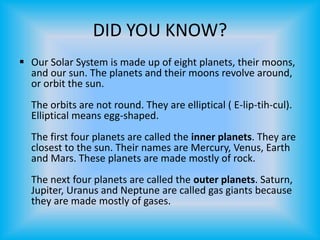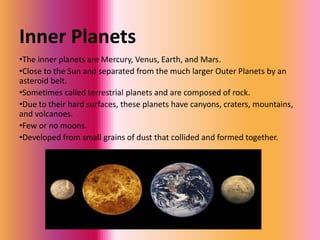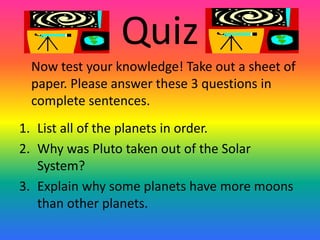Our solar system
- 1. Our Solar System By Julie Bingaman 5th Grade
- 2. DID YOU KNOW? ï§ Our Solar System is made up of eight planets, their moons, and our sun. The planets and their moons revolve around, or orbit the sun. The orbits are not round. They are elliptical ( E-lip-tih-cul). Elliptical means egg-shaped. The first four planets are called the inner planets. They are closest to the sun. Their names are Mercury, Venus, Earth and Mars. These planets are made mostly of rock. The next four planets are called the outer planets. Saturn, Jupiter, Uranus and Neptune are called gas giants because they are made mostly of gases.
- 3. The Source âĒ The Sun is the most prominent feature in our solar system. It is the largest object and contains approximately 98% of the total solar system mass âĒ The Sun is the star at the center of the Solar System âĒ The Sun's color is white, although from the surface of the Earth it may appear yellow because of atmospheric scattering of blue light âĒ designated a yellow star, because its visible radiation is most intense in the yellow- green portion of the spectrum
- 4. Inner Planets âĒThe inner planets are Mercury, Venus, Earth, and Mars. âĒClose to the Sun and separated from the much larger Outer Planets by an asteroid belt. âĒSometimes called terrestrial planets and are composed of rock. âĒDue to their hard surfaces, these planets have canyons, craters, mountains, and volcanoes. âĒFew or no moons. âĒDeveloped from small grains of dust that collided and formed together.
- 5. Mercury âĒ Closest planet to the sun âĒ 2nd smallest planet in the solar system âĒ The surface is similar to that of Earthâs moon âĒ Virtually has no atmosphere âĒ Mercury rotates 1 Â― times during each orbit âĒ 1 day on Mercury=176 Earth days âĒ Small magnetic field, which means there are no satellites
- 6. Venus âĒ 2nd Planet from the sun âĒ Brightest object in the sky except for the sun and moon âĒ 1 Venus day= 243 Earth days âĒ Regarded as Earthâs sister planet âĒ Some ways similar to Earth, only slightly smaller âĒ Atmosphere is made up most of Carbon Dioxide âĒ No magnetic field, which means it has no satellites (moons)
- 7. Earth âĒ 3rd planet from the sun âĒ 5th largest planet in the solar system âĒ 71 Percent of the Earth's surface is covered with water. âĒ Only planet on which water can exist in liquid form on the surface âĒ The Earth's magnetic field and its interaction with the solar wind also produce the Van Allen radiation belts âĒ Has one natural satellite called the moon
- 8. Mars âĒ 4th planet from the sun âĒ 7th largest in the solar system âĒ Referred to as the Red planet âĒ Most favorable place in the Solar System (other than Earth) âĒ Mars' orbit is significantly elliptical âĒ Though Mars is much smaller than Earth, its surface area is about the same as the land surface area of Earth âĒ Weak magnetic fields exist in various regions of Mars âĒ When it is in the nighttime sky, Mars is easily visible with the unaided eye âĒ Mars has two tiny satellites called Phobos and Deimos
- 9. Outer Planets âĒThe outer planets are Jupiter, Saturn, Uranus, and Neptune. âĒLocated outside of the asteroid belt. âĒThese planets are much larger than the inner planets and are called gas giants as they are composed primarily of hydrogen and helium. âĒNo solid surface. The hydrogen and helium are in gas form in the atmosphere and below that in a liquid state. âĒEach has many moons and rings.
- 10. Jupiter âĒ Jupiter is the fifth planet from the Sun and by far the largest. âĒ Jupiter is more than twice as massive as all the other planets combined (the mass of Jupiter is 318 times that of Earth). âĒ Jupiter is the fourth brightest object in the sky (after the Sun, the Moon and Venus). âĒ Jupiter has 63 known satellites (as of Feb 2004): the four large Galilean moons plus many more small ones âĒ Jupiter has rings like Saturn's, but much fainter and smaller
- 11. Saturn âĒ Saturn is the sixth planet from the Sun and the second largest âĒ Saturn has 53 named satellites âĒ Saturn is the least dense of the planets; its specific gravity (0.7) is less than that of water. âĒ Saturn's rings are extraordinarily thin, there are two prominent rings (A and B) and one faint ring (C) can be seen from the Earth âĒ In the nighttime sky, Saturn is easily visible to the unaided eye âĒ Like the other Jovian planets, Saturn has a significant magnetic field.
- 12. Uranus âĒ Uranus is the 7th planet from the sun and the third largest âĒ Most of the planets spin on an axis nearly perpendicular to the plane of the ecliptic but Uranus' axis is almost parallel to the ecliptic âĒ Primarily composed of rock and various ices âĒ Uranus' blue color is the result of absorption of red light by methane in the upper atmosphere âĒ Uranus has 11 known rings âĒ Uranus has 27 named moons
- 13. Neptune âĒ Neptune is the eighth planet from the Sun and the fourth largest âĒ Neptune's blue color is largely the result of absorption of red light by methane in the atmosphere but there is some additional as-yet- unidentified chromophore which gives the clouds their rich blue tint. âĒ Little is still know of Neptune because there has only been one visit of a spacecraft there âĒ Neptune's winds are the fastest in the solar system, reaching 2000 km/hour. âĒ Neptune's rings are very dark but their composition is unknown. âĒ Neptune has 13 known moons; 7 small named ones
- 14. Guess What? âĒ Pluto was once a part of our solar system âĒ In 2006 scientist found 2 other âplanetsâ in our solar system that were thought to be the moons of Neptune. Since they were bigger than Pluto, scientists decided to take Pluto out of the solar system âĒ It is now called a Dwarf planet
- 15. Pluto âĒ Pluto orbits beyond the orbit of Neptune (usually). âĒ It is smaller than many moons, therefore it is now called a Dwarf Planet âĒ A spacecraft has never visited Pluto âĒ Pluto rotates in the opposite direction from most of the other planets. âĒ Charon ( "KAIR en" ) is Pluto's largest satellite:
- 16. Hereâs the thing about moons âĒ Did you know? It is a combination of the amount of gravitational pull and the size of the planet as to why some planets have more moons than others! Remember a moon is a satellite, it orbits around itsâ host planet. âĒ Which planets have moons? âĒ Earth (1) âĒ Mars (2) âĒ Jupiter (63) âĒ Saturn(53) âĒ Uranus (27) âĒ Neptune (13) âĒ Pluto (1)
- 17. Quiz Now test your knowledge! Take out a sheet of paper. Please answer these 3 questions in complete sentences. 1. List all of the planets in order. 2. Why was Pluto taken out of the Solar System? 3. Explain why some planets have more moons than other planets.
- 18. Hereâs a SOLAR-TASTIC movie and game Movie http://video.kids.nationalgeographic.com/video /player/kids/science-space-kids/solar-system- 101-kids.html Game http://kids.nationalgeographic.com/kids/games/ actiongames/space-janitor/
- 19. Websites for kids Planet Facts: http://www.kidsastronomy.com/solar_system.htm Puzzle Games: http://solarsystem.nasa.gov/kids/puzzles.cfm Journey of the Solar System: http://www.kids-and-space.com/ Moon: http://www.woodlands-junior.kent.sch.uk/time/moon/facts.htm
Editor's Notes
- #2: All images from Google Images: http://www.google.com/images?um=1&hl=en&rlz=1R2SKPT_enUS399&biw=1436&bih=659&tbs=isch%3A1&sa=1&q=solar+system&aq=0&aqi=g10&aql=&oq=solar+sy&gs_rfai=
- #3: Information taken from this website: http://www.manatee.k12.fl.us/sites/elementary/samoset/psgsolar.htm
- #4: Information from: http://www.solarviews.com/eng/sun.htm
- #5: Information from: http://www.blogiversity.org/blogs/gimmesomespace/archive/2009/04/29/interesting-facts-about-the-inner-planets.aspx
- #6: Most information taken from: http://www.solarviews.com/eng/mercury.htm Image from google images
- #7: Information from: http://nineplanets.org/venus.html Image from Google Images: http://www.tivas.org.uk/solsys/images/venus.jpg
- #8: Information from: http://webcache.googleusercontent.com/search?q=cache:Zzt9DyOl870J:nineplanets.org/earth.html+earth&cd=5&hl=en&ct=clnk&gl=us Image from Google Images: http://rst.gsfc.nasa.gov/Sect19/earth-3d-space-tour-big.jpg
- #9: Information from: http://nineplanets.org/mars.html Images from: http://www.hoax-slayer.com/images/mars.jpg
- #10: Information from: http://www.blogiversity.org/blogs/gimmesomespace/archive/2009/05/11/interesting-facts-about-the-outer-planets.aspx
- #11: Information from: http://nineplanets.org/jupiter.html Image from Google Images: http://www.google.com/imgres?imgurl=http://www.ultimateuniverse.net/images/jupiter.jpg&imgrefurl=http://www.ultimateuniverse.net/jupiter.html&usg=__2lsKtGC99Zjj6XFTj9rp7XMBjus=&h=305&w=300&sz=9&hl=en&start=0&zoom=1&tbnid=vooYPtiMOJ5HpM:&tbnh=167&tbnw=170&prev=/images%3Fq%3Djupiter%26um%3D1%26hl%3Den%26sa%3DX%26rlz%3D1R2SKPT_enUS399%26biw%3D1436%26bih%3D687%26tbs%3Disch:1&um=1&itbs=1&iact=hc&vpx=355&vpy=115&dur=2117&hovh=226&hovw=223&tx=97&ty=124&ei=yIrLTKmcOMS9nAffyLX9Dw&oei=sIrLTNDwB8qmnAfd_NzpDw&esq=9&page=1&ndsp=18&ved=1t:429,r:1,s:0
- #12: Information from: http://nineplanets.org/saturn.html Images from Google Images: http://www.google.com/imgres?imgurl=http://lonelylemoncrafts.files.wordpress.com/2010/03/saturn.jpg&imgrefurl=http://lonelylemoncrafts.wordpress.com/&usg=__qLInj-XH0ZUNUIPEF6_R-QxzN2c=&h=360&w=360&sz=58&hl=en&start=0&zoom=1&tbnid=MRfDW2bT4mN3_M:&tbnh=156&tbnw=156&prev=/images%3Fq%3Dsaturn%26um%3D1%26hl%3Den%26sa%3DX%26rlz%3D1R2SKPT_enUS399%26biw%3D1436%26bih%3D659%26tbs%3Disch:1&um=1&itbs=1&iact=rc&dur=150&ei=dpHLTNm_IJKcnwfh5rDaDw&oei=dpHLTNm_IJKcnwfh5rDaDw&esq=1&page=1&ndsp=18&ved=1t:429,r:14,s:0&tx=39&ty=81
- #13: Information from: http://nineplanets.org/uranus.html Images from Google Images: http://www.google.com/imgres?imgurl=http://www.freemars.org/jeff/planets/Uranus2.jpg&imgrefurl=http://www.freemars.org/jeff/planets/Uranus.htm&usg=__kAZN18dsCMbgZCqZ9TXSmEp59_I=&h=450&w=400&sz=13&hl=en&start=21&zoom=1&tbnid=f-C2loQwk5Pf1M:&tbnh=155&tbnw=132&prev=/images%3Fq%3Duranus%26um%3D1%26hl%3Den%26sa%3DX%26rlz%3D1R2SKPT_enUS399%26biw%3D1436%26bih%3D659%26tbs%3Disch:1&um=1&itbs=1&iact=rc&dur=730&ei=_5HLTPzyFMurnQfOneTGDw&oei=2ZHLTITTJqmsnAeq3oHmDw&esq=11&page=2&ndsp=21&ved=1t:429,r:14,s:21&tx=104&ty=119
- #14: Information from: http://nineplanets.org/neptune.html Images from Google Images: http://www.google.com/imgres?imgurl=http://www.biochem.szote.u-szeged.hu/astrojan/neptune.jpg&imgrefurl=http://www.biochem.szote.u-szeged.hu/astrojan/neptune.htm&usg=__QAQc7C416XGDT-oxpkdFkmUCjyo=&h=301&w=301&sz=10&hl=en&start=0&zoom=1&tbnid=NSNjzSpWQk8_9M:&tbnh=158&tbnw=165&prev=/images%3Fq%3Dneptune%26um%3D1%26hl%3Den%26sa%3DX%26rlz%3D1R2SKPT_enUS399%26biw%3D1436%26bih%3D659%26tbs%3Disch:10%2C20&um=1&itbs=1&iact=hc&vpx=1168&vpy=90&dur=235&hovh=225&hovw=225&tx=131&ty=135&ei=TJbLTOjNFI7anAfMy6EY&oei=KZbLTImRI8TJnAf8h7HrDw&esq=10&page=1&ndsp=21&ved=1t:429,r:6,s:0&biw=1436&bih=659
- #16: Information from: http://nineplanets.org/pluto.html Images from Google Images: http://www.google.com/imgres?imgurl=http://www.backtowild.com/wp-content/uploads/2007/09/pluto.jpg&imgrefurl=http://www.backtowild.com/2007/09/28/facts-about-pluto/&h=350&w=350&sz=15&tbnid=N_QPI8VTjLRwMM:&tbnh=120&tbnw=120&prev=/images%3Fq%3Dpluto&zoom=1&q=pluto&hl=en&usg=__l-eGtEPJ_nN6hqz_CtRNZzpppUY=&sa=X&ei=opjLTIiOO8rOnAfWz7XhDw&sqi=2&ved=0CDQQ9QEwAw
- #18: Pictures are used from clip art
- #19: Movie from National Geographic Kids








































































